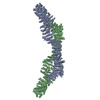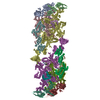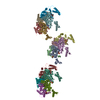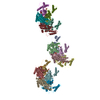+ Open data
Open data
- Basic information
Basic information
| Entry | Database: PDB / ID: 7mp6 | ||||||
|---|---|---|---|---|---|---|---|
| Title | Neurofibromin homodimer | ||||||
 Components Components | Isoform I of Neurofibromin | ||||||
 Keywords Keywords | ANTITUMOR PROTEIN / tumor supressor / HEAT repeat / Ras-GAP / scaffold | ||||||
| Function / homology |  Function and homology information Function and homology informationpositive regulation of mast cell apoptotic process / negative regulation of Rac protein signal transduction / regulation of glial cell differentiation / observational learning / negative regulation of Schwann cell migration / Schwann cell migration / amygdala development / vascular associated smooth muscle cell migration / Schwann cell proliferation / negative regulation of mast cell proliferation ...positive regulation of mast cell apoptotic process / negative regulation of Rac protein signal transduction / regulation of glial cell differentiation / observational learning / negative regulation of Schwann cell migration / Schwann cell migration / amygdala development / vascular associated smooth muscle cell migration / Schwann cell proliferation / negative regulation of mast cell proliferation / mast cell apoptotic process / gamma-aminobutyric acid secretion, neurotransmission / vascular associated smooth muscle cell proliferation / glutamate secretion, neurotransmission / negative regulation of Schwann cell proliferation / mast cell proliferation / negative regulation of leukocyte migration / negative regulation of neurotransmitter secretion / forebrain morphogenesis / regulation of cell-matrix adhesion / hair follicle maturation / regulation of blood vessel endothelial cell migration / cell communication / camera-type eye morphogenesis / smooth muscle tissue development / negative regulation of oligodendrocyte differentiation / sympathetic nervous system development / myeloid leukocyte migration / peripheral nervous system development / myelination in peripheral nervous system / phosphatidylcholine binding / negative regulation of Ras protein signal transduction / metanephros development / phosphatidylethanolamine binding / positive regulation of extrinsic apoptotic signaling pathway in absence of ligand / regulation of long-term synaptic potentiation / collagen fibril organization / endothelial cell proliferation / regulation of postsynapse organization / regulation of bone resorption / neural tube development / artery morphogenesis / forebrain astrocyte development / adrenal gland development / negative regulation of neuroblast proliferation / regulation of synaptic transmission, GABAergic / negative regulation of protein import into nucleus / pigmentation / spinal cord development / negative regulation of astrocyte differentiation / negative regulation of vascular associated smooth muscle cell migration / negative regulation of endothelial cell proliferation / Rac protein signal transduction / negative regulation of osteoclast differentiation / oligodendrocyte differentiation / RAS signaling downstream of NF1 loss-of-function variants / extrinsic apoptotic signaling pathway via death domain receptors / positive regulation of GTPase activity / negative regulation of cell-matrix adhesion / neuroblast proliferation / regulation of angiogenesis / regulation of ERK1 and ERK2 cascade / Schwann cell development / negative regulation of fibroblast proliferation / skeletal muscle tissue development / negative regulation of stem cell proliferation / negative regulation of MAPK cascade / positive regulation of vascular associated smooth muscle cell proliferation / positive regulation of endothelial cell proliferation / extrinsic apoptotic signaling pathway in absence of ligand / extracellular matrix organization / GTPase activator activity / osteoclast differentiation / negative regulation of angiogenesis / negative regulation of cell migration / stem cell proliferation / phosphatidylinositol 3-kinase/protein kinase B signal transduction / wound healing / liver development / regulation of long-term neuronal synaptic plasticity / brain development / visual learning / cerebral cortex development / Regulation of RAS by GAPs / cognition / long-term synaptic potentiation / protein import into nucleus / osteoblast differentiation / positive regulation of neuron apoptotic process / MAPK cascade / presynapse / regulation of gene expression / cellular response to heat / heart development / actin cytoskeleton organization / neuron apoptotic process / fibroblast proliferation / angiogenesis / Ras protein signal transduction / response to hypoxia Similarity search - Function | ||||||
| Biological species |  Homo sapiens (human) Homo sapiens (human) | ||||||
| Method | ELECTRON MICROSCOPY / single particle reconstruction / cryo EM / Resolution: 6.25 Å | ||||||
 Authors Authors | Lupton, C.J. / Bayly-Jones, C. / Ellisdon, A.M. | ||||||
| Funding support |  Australia, 1items Australia, 1items
| ||||||
 Citation Citation |  Journal: Nat Struct Mol Biol / Year: 2021 Journal: Nat Struct Mol Biol / Year: 2021Title: The cryo-EM structure of the human neurofibromin dimer reveals the molecular basis for neurofibromatosis type 1. Authors: Christopher J Lupton / Charles Bayly-Jones / Laura D'Andrea / Cheng Huang / Ralf B Schittenhelm / Hari Venugopal / James C Whisstock / Michelle L Halls / Andrew M Ellisdon /  Abstract: Neurofibromin (NF1) mutations cause neurofibromatosis type 1 and drive numerous cancers, including breast and brain tumors. NF1 inhibits cellular proliferation through its guanosine triphosphatase- ...Neurofibromin (NF1) mutations cause neurofibromatosis type 1 and drive numerous cancers, including breast and brain tumors. NF1 inhibits cellular proliferation through its guanosine triphosphatase-activating protein (GAP) activity against rat sarcoma (RAS). In the present study, cryo-electron microscope studies reveal that the human ~640-kDa NF1 homodimer features a gigantic 30 × 10 nm array of α-helices that form a core lemniscate-shaped scaffold. Three-dimensional variability analysis captured the catalytic GAP-related domain and lipid-binding SEC-PH domains positioned against the core scaffold in a closed, autoinhibited conformation. We postulate that interaction with the plasma membrane may release the closed conformation to promote RAS inactivation. Our structural data further allow us to map the location of disease-associated NF1 variants and provide a long-sought-after structural explanation for the extreme susceptibility of the molecule to loss-of-function mutations. Collectively these findings present potential new routes for therapeutic modulation of the RAS pathway. | ||||||
| History |
|
- Structure visualization
Structure visualization
| Movie |
 Movie viewer Movie viewer |
|---|---|
| Structure viewer | Molecule:  Molmil Molmil Jmol/JSmol Jmol/JSmol |
- Downloads & links
Downloads & links
- Download
Download
| PDBx/mmCIF format |  7mp6.cif.gz 7mp6.cif.gz | 600.7 KB | Display |  PDBx/mmCIF format PDBx/mmCIF format |
|---|---|---|---|---|
| PDB format |  pdb7mp6.ent.gz pdb7mp6.ent.gz | 462 KB | Display |  PDB format PDB format |
| PDBx/mmJSON format |  7mp6.json.gz 7mp6.json.gz | Tree view |  PDBx/mmJSON format PDBx/mmJSON format | |
| Others |  Other downloads Other downloads |
-Validation report
| Summary document |  7mp6_validation.pdf.gz 7mp6_validation.pdf.gz | 1.1 MB | Display |  wwPDB validaton report wwPDB validaton report |
|---|---|---|---|---|
| Full document |  7mp6_full_validation.pdf.gz 7mp6_full_validation.pdf.gz | 1.1 MB | Display | |
| Data in XML |  7mp6_validation.xml.gz 7mp6_validation.xml.gz | 80.1 KB | Display | |
| Data in CIF |  7mp6_validation.cif.gz 7mp6_validation.cif.gz | 129.5 KB | Display | |
| Arichive directory |  https://data.pdbj.org/pub/pdb/validation_reports/mp/7mp6 https://data.pdbj.org/pub/pdb/validation_reports/mp/7mp6 ftp://data.pdbj.org/pub/pdb/validation_reports/mp/7mp6 ftp://data.pdbj.org/pub/pdb/validation_reports/mp/7mp6 | HTTPS FTP |
-Related structure data
| Related structure data |  23930MC  7mocC  7mp5C M: map data used to model this data C: citing same article ( |
|---|---|
| Similar structure data |
- Links
Links
- Assembly
Assembly
| Deposited unit | 
|
|---|---|
| 1 |
|
- Components
Components
| #1: Protein | Mass: 318407.812 Da / Num. of mol.: 2 Source method: isolated from a genetically manipulated source Source: (gene. exp.)  Homo sapiens (human) / Gene: NF1 / Production host: Homo sapiens (human) / Gene: NF1 / Production host:  |
|---|
-Experimental details
-Experiment
| Experiment | Method: ELECTRON MICROSCOPY |
|---|---|
| EM experiment | Aggregation state: PARTICLE / 3D reconstruction method: single particle reconstruction |
- Sample preparation
Sample preparation
| Component | Name: Neurofibromin homodimer / Type: COMPLEX / Entity ID: all / Source: RECOMBINANT |
|---|---|
| Molecular weight | Value: 0.63 MDa / Experimental value: YES |
| Source (natural) | Organism:  Homo sapiens (human) Homo sapiens (human) |
| Source (recombinant) | Organism:  |
| Buffer solution | pH: 8 |
| Specimen | Embedding applied: NO / Shadowing applied: NO / Staining applied: NO / Vitrification applied: YES |
| Vitrification | Cryogen name: ETHANE |
- Electron microscopy imaging
Electron microscopy imaging
| Experimental equipment |  Model: Talos Arctica / Image courtesy: FEI Company |
|---|---|
| Microscopy | Model: FEI TALOS ARCTICA |
| Electron gun | Electron source:  FIELD EMISSION GUN / Accelerating voltage: 200 kV / Illumination mode: FLOOD BEAM FIELD EMISSION GUN / Accelerating voltage: 200 kV / Illumination mode: FLOOD BEAM |
| Electron lens | Mode: BRIGHT FIELD |
| Image recording | Electron dose: 40 e/Å2 / Detector mode: COUNTING / Film or detector model: FEI FALCON III (4k x 4k) |
- Processing
Processing
| CTF correction | Type: PHASE FLIPPING AND AMPLITUDE CORRECTION |
|---|---|
| Symmetry | Point symmetry: C2 (2 fold cyclic) |
| 3D reconstruction | Resolution: 6.25 Å / Resolution method: FSC 0.143 CUT-OFF / Num. of particles: 95564 / Symmetry type: POINT |
 Movie
Movie Controller
Controller












 PDBj
PDBj

